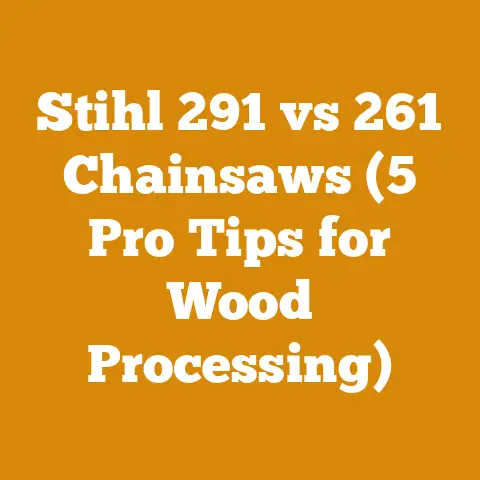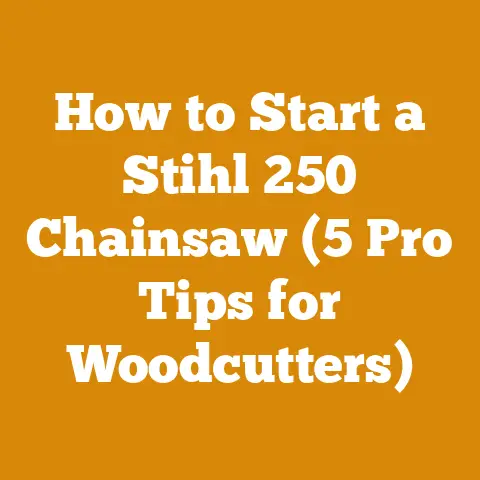Herbicide for Woody Plants (5 Expert Tips for Effective Brush Control)
Let’s dive into brush control, a critical aspect of responsible land management, especially crucial if you’re involved in logging, firewood preparation, or even just maintaining your property. Over the years, I’ve seen firsthand how unchecked woody plants can quickly overrun a forest, choking out valuable timber species, hindering access, and increasing the risk of wildfires. Using herbicides effectively is a powerful tool, but it’s one that demands respect and understanding. I’m going to share my experiences and insights, focusing on practical tips to help you achieve effective brush control while prioritizing safety and environmental responsibility.
Herbicide for Woody Plants: 5 Expert Tips for Effective Brush Control
Controlling unwanted woody plants is not just about aesthetics; it’s about maintaining healthy ecosystems, promoting timber growth, and ensuring safe working conditions in the woods. Think of it as weeding your garden, but on a much larger scale. The goal is to selectively remove undesirable vegetation while allowing desirable trees and plants to thrive.
1. Correct Identification: Know Your Enemy
Before reaching for any herbicide, the single most important step is accurate plant identification. You need to know exactly what you’re targeting. Is it buckthorn, multiflora rose, tree of heaven, or something else? Each species responds differently to various herbicides. Misidentification can lead to ineffective treatment, wasted product, and potential harm to non-target plants.
Why is this so important?
Imagine you’re trying to cure a disease, but you don’t know what disease it is. You might end up using the wrong medication, making the situation worse. The same principle applies to herbicide application. Different woody plants have different vulnerabilities. Some are easily killed with foliar sprays, while others require more aggressive methods like cut-stump treatments.
My Experience:
Early in my career, I misidentified a type of sumac. I used a general-purpose herbicide that was ineffective. Weeks later, the sumac was still thriving. I then realized my mistake, switched to a herbicide specifically formulated for sumac control, and achieved complete kill. That experience taught me the invaluable lesson of “know your enemy.”
Practical Steps for Identification:
- Use Field Guides: Invest in a good field guide specific to your region. Peterson Field Guides and Audubon Society Field Guides are excellent resources.
- Online Resources: Websites like the USDA Plants Database (plants.usda.gov) offer detailed information and images of plants.
- Local Experts: Contact your local extension office or a certified arborist. They can often help with plant identification.
- Key Characteristics to Look For: Pay attention to leaf shape, bark texture, flower color, fruit type, and growth habit. Take pictures to compare with online resources.
2. Herbicide Selection: Choosing the Right Weapon
Once you’ve identified the target species, the next crucial step is selecting the appropriate herbicide. Not all herbicides are created equal. Some are broad-spectrum, killing a wide range of plants, while others are selective, targeting specific species. The choice depends on the target species, the surrounding vegetation, and your overall management goals.
Understanding Herbicide Labels:
The herbicide label is your legal and informational guide. Read it carefully before using any product. The label provides critical information on:
- Target Species: Which plants the herbicide is effective against.
- Application Rates: The correct amount of herbicide to use per unit area or volume.
- Application Methods: Recommended methods, such as foliar spray, cut-stump treatment, or basal bark application.
- Safety Precautions: Personal protective equipment (PPE) required and environmental hazards.
- Environmental Considerations: Restrictions on use near water bodies or sensitive areas.
Common Herbicides for Woody Plants:
- Glyphosate: A broad-spectrum herbicide effective against many woody plants. It’s non-selective, meaning it will kill any plant it comes into contact with. Trade names include Roundup, Rodeo (aquatic formulation), and Accord.
- Application: Foliar spray, cut-stump treatment.
- Caution: Can harm non-target plants. Use with care near desirable vegetation.
- Triclopyr: A selective herbicide effective against many broadleaf woody plants. It’s less harmful to grasses. Trade names include Garlon, Remedy Ultra, and Pathfinder II (oil-based formulation for basal bark application).
- Application: Foliar spray, cut-stump treatment, basal bark application.
- Caution: Can injure desirable broadleaf plants.
- Imazapyr: A broad-spectrum herbicide with long-lasting residual activity in the soil. It’s effective against many woody plants, but can also prevent the growth of new vegetation for an extended period. Trade names include Arsenal and Stalker.
- Application: Cut-stump treatment, soil application (restricted use).
- Caution: Use with extreme caution due to its long-lasting effects. Avoid use near desirable plants or in areas where you plan to replant.
- 2,4-D: A selective herbicide primarily used for broadleaf weed control. It can be effective against some woody plants, especially when mixed with other herbicides.
- Application: Foliar spray.
- Caution: Can drift and damage desirable broadleaf plants. Use with care on windy days.
Choosing the Right Formulation:
Herbicides come in various formulations, including:
- Concentrates: Must be diluted with water or oil before use. More economical for large-scale applications.
- Ready-to-Use (RTU): Pre-mixed and ready to apply. Convenient for small-scale applications.
- Granules: Applied to the soil. Often used for pre-emergent weed control.
My Story:
I once had a client who was battling a severe infestation of multiflora rose. They had tried glyphosate with limited success. After analyzing the situation, I recommended a combination of triclopyr and glyphosate. Triclopyr is particularly effective on roses, while glyphosate provides broader control. The combination proved highly successful, and the client was finally able to regain control of their property.
Data and Insights:
Studies have shown that using herbicide mixtures can often lead to better control of woody plants than using a single herbicide alone. This is because different herbicides have different modes of action, and a mixture can target multiple weaknesses in the plant. However, it’s crucial to follow label instructions and consult with a professional to ensure the mixture is safe and effective.
Expert Tip:
When selecting an herbicide, consider the selectivity of the product. If you’re working in an area with desirable trees or shrubs, choose a selective herbicide that will target the unwanted woody plants without harming the desirable vegetation.
3. Application Techniques: Precision is Key
The success of any herbicide treatment hinges on proper application. Sloppy or careless application can lead to ineffective control, damage to non-target plants, and environmental contamination.
Common Application Methods:
-
Foliar Spray: Applying herbicide directly to the leaves of the target plant. This method is most effective when the plant is actively growing and has a full canopy of leaves.
- Equipment: Backpack sprayer, ATV sprayer, boom sprayer.
- Technique: Thoroughly wet the leaves of the target plant, but avoid excessive runoff. Spray on calm days to minimize drift.
- My Experience: I’ve found that adding a surfactant (a wetting agent) to the spray mixture can significantly improve herbicide uptake, especially on plants with waxy leaves.
-
Cut-Stump Treatment: Applying herbicide to the freshly cut surface of a stump. This method is effective for preventing resprouting of woody plants.
- Equipment: Hand sprayer, paintbrush, squirt bottle.
- Technique: Cut the stem close to the ground and immediately apply herbicide to the entire cut surface, including the bark.
- Case Study: I once used the cut-stump method to control tree of heaven, a highly invasive species. I cut the trees in late winter and applied glyphosate to the stumps. The treatment was highly effective, and the trees did not resprout.
-
Basal Bark Application: Applying herbicide to the lower portion of the stem. This method is effective for controlling thin-barked woody plants.
- Equipment: Backpack sprayer with a specialized nozzle.
- Technique: Spray the lower 12-18 inches of the stem, thoroughly wetting the bark. Use an oil-based herbicide formulation for better penetration.
- Insight: Basal bark application is best done in the dormant season when the plant is not actively growing.
-
Hack-and-Squirt: Making cuts into the bark of the tree and applying herbicide into the cuts. This method is effective for controlling larger trees.
- Equipment: Hatchet or axe, squirt bottle.
- Technique: Make downward-angled cuts into the bark, spaced a few inches apart around the circumference of the tree. Apply herbicide into each cut.
- Caution: Be careful when using an axe or hatchet. Always wear appropriate safety gear.
Factors Affecting Application Effectiveness:
- Weather Conditions: Avoid spraying on windy days or when rain is expected. Wind can cause herbicide drift, and rain can wash the herbicide off the plant.
- Plant Growth Stage: Herbicides are most effective when plants are actively growing. Avoid spraying during periods of drought or dormancy.
- Herbicide Concentration: Use the correct herbicide concentration as specified on the label. Too little herbicide will be ineffective, while too much can damage non-target plants.
- Equipment Calibration: Calibrate your sprayer to ensure you’re applying the correct amount of herbicide.
Tool Specifications:
- Backpack Sprayer: Look for a sprayer with adjustable pressure and a variety of nozzles. A good quality backpack sprayer will last for years with proper maintenance.
- ATV Sprayer: Useful for large-scale applications. Choose a sprayer with a boom that is wide enough to cover the area you’re treating.
- Hand Sprayer: Convenient for small-scale applications and spot treatments.
- Chainsaw: For cut-stump treatments, a reliable chainsaw is essential. I prefer a mid-sized saw with a 16-18 inch bar for most brush control work. Stihl and Husqvarna are two reputable brands.
Measurements:
- Application Rate: Always follow the application rates specified on the herbicide label. These rates are typically expressed in ounces or pounds of herbicide per acre or per gallon of water.
- Spray Volume: The amount of spray solution needed to thoroughly wet the target plants will vary depending on the plant species and size. As a general rule, aim for 50-100 gallons of spray solution per acre for foliar applications.
Strategic Advantages:
- Targeted Control: Proper application techniques allow you to target specific plants, minimizing the impact on desirable vegetation.
- Reduced Herbicide Use: By applying herbicide precisely, you can reduce the amount of herbicide needed, saving money and reducing environmental impact.
- Improved Effectiveness: Proper application ensures that the herbicide reaches the target plant and is absorbed effectively.
Costs:
The cost of herbicide application will vary depending on the herbicide used, the application method, and the size of the area being treated. As a rough estimate, expect to spend \$50-\$200 per acre for herbicide application.
4. Timing is Everything: When to Strike
Timing is critical for effective brush control. Applying herbicide at the wrong time of year can lead to poor results and wasted effort. The best time to apply herbicide depends on the target species, the application method, and the herbicide being used.
General Guidelines:
- Foliar Applications: Best done during the growing season when plants are actively growing and have a full canopy of leaves. Avoid spraying during periods of drought or extreme heat. Late spring and early fall are often ideal times for foliar applications.
- Cut-Stump Treatments: Can be done any time of year, but are most effective when done shortly after cutting the stem. Winter is a good time for cut-stump treatments, as the lack of foliage makes it easier to access the stumps.
- Basal Bark Applications: Best done during the dormant season when the plant is not actively growing. This allows the herbicide to penetrate the bark more effectively.
Specific Examples:
- Buckthorn: Foliar applications are most effective in the fall after native plants have gone dormant. Cut-stump treatments can be done any time of year, but are most effective when done in the winter.
- Multiflora Rose: Foliar applications are most effective in the late spring or early summer when the plants are actively growing. Cut-stump treatments can be done any time of year.
- Tree of Heaven: Cut-stump treatments are most effective when done in the late summer or early fall. This allows the herbicide to translocate to the roots before the plant goes dormant.
My Observations:
I’ve noticed that herbicide effectiveness can vary depending on the weather patterns in a given year. For example, a dry spring can reduce herbicide uptake, while a wet spring can increase it. It’s important to monitor the weather and adjust your application schedule accordingly.
Technical Details:
- Moisture Content: The moisture content of the plant can affect herbicide uptake. Plants that are stressed by drought may have reduced herbicide uptake.
- Temperature: High temperatures can increase herbicide volatility and drift. Avoid spraying on days when the temperature is above 85°F.
- Wind Speed: Wind can cause herbicide drift. Avoid spraying on days when the wind speed is above 10 mph.
Benefits:
- Maximized Effectiveness: Applying herbicide at the right time maximizes its effectiveness, leading to better control of woody plants.
- Reduced Herbicide Use: By applying herbicide at the optimal time, you can reduce the amount of herbicide needed, saving money and reducing environmental impact.
- Improved Plant Health: Controlling woody plants at the right time can improve the health and vigor of desirable plants.
Timing Estimates:
- Foliar Application: 1-2 days per acre.
- Cut-Stump Treatment: 2-4 days per acre.
- Basal Bark Application: 3-5 days per acre.
5. Safety First: Protecting Yourself and the Environment
Herbicide application can be hazardous if not done properly. It’s essential to prioritize safety to protect yourself, your workers, and the environment.
Personal Protective Equipment (PPE):
- Gloves: Wear chemical-resistant gloves to protect your skin from herbicide exposure.
- Eye Protection: Wear safety glasses or a face shield to protect your eyes from herbicide splashes.
- Long Sleeves and Pants: Wear long sleeves and pants to protect your skin from herbicide exposure.
- Respirator: Wear a respirator if you’re spraying herbicides in enclosed spaces or if you’re sensitive to herbicides.
- Boots: Wear waterproof boots to protect your feet from herbicide exposure.
Environmental Considerations:
- Water Bodies: Avoid spraying herbicides near water bodies. Herbicides can contaminate water and harm aquatic life.
- Sensitive Areas: Avoid spraying herbicides in sensitive areas such as wetlands, endangered species habitats, and organic farms.
- Drift: Minimize herbicide drift by spraying on calm days and using drift-reducing nozzles.
- Spills: Clean up any herbicide spills immediately.
- Disposal: Dispose of empty herbicide containers properly. Follow the instructions on the label.
My Biggest Mistake:
I once got a small amount of herbicide on my skin while I wasn’t wearing gloves. I didn’t wash it off immediately, and I developed a rash. It was a painful reminder of the importance of wearing PPE.
Safety Standards:
- OSHA: The Occupational Safety and Health Administration (OSHA) has regulations regarding the safe use of herbicides in the workplace.
- EPA: The Environmental Protection Agency (EPA) regulates the registration and use of herbicides in the United States.
Strategic Insights:
- Training: Provide thorough training to all workers who will be applying herbicides.
- Communication: Communicate with neighbors and landowners about your herbicide application plans.
- Record Keeping: Keep accurate records of all herbicide applications, including the date, time, location, herbicide used, and application rate.
Cost of Safety:
The cost of PPE and safety training is a small price to pay compared to the potential costs of an accident or environmental contamination.
Next Steps:
Now that you understand the key principles of effective brush control, it’s time to put your knowledge into practice. Start by identifying the woody plants on your property and selecting the appropriate herbicide. Then, carefully plan your application, paying attention to timing, weather conditions, and safety precautions. With careful planning and execution, you can effectively control unwanted woody plants and maintain a healthy, productive landscape. Remember, always read and follow the herbicide label instructions. If you are unsure about anything, consult with a certified professional. Good luck, and stay safe out there!






